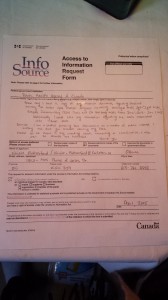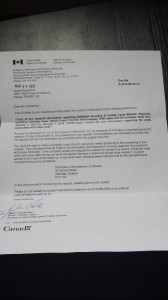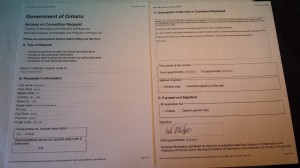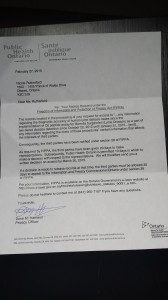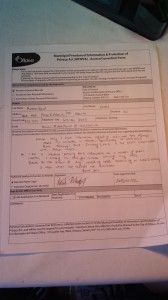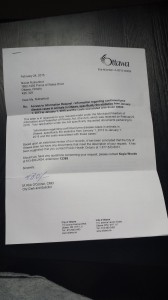Nearly a year after they announced widespread cuts to their national operating budget, the CBC is doing what it can to tell stories with fewer resources. While this approach may help keep expenses down, it has left the residents of Wabush, Newfoundland feeling alienated.
Nestled in North-West Newfoundland, Wabush is a mining town which exports iron ore to countries with expanding industrial sectors. While it once thrived, Wabush is currently struggling to survive due to the shaky prices of iron in international markets. Countries like China who were once willing to pay top dollar for the resource now pay only half the price. Business has slowed down as a result.
Prior to the cuts CBC had one reporter and vidoegrapher covering Wabush stories as a part of its larger Labrador West region. Last year, that reporter retired, and the videographer was relocated to a different location.
With the reporters gone, Wabush’s mayor Colin Vardy was afraid that his town would lose its only national platform. A letter obtained through an Access to information request reveals that Vardy personally appealed to CBC president Hubert Lacroix, requesting that the broadcaster hold off on making any changes to the CBC’s coverage of Wabush and the Labrador West region.
The positions in West Labrador still have not been replaced. This concerns Vardy, who says that the stories in his town aren’t getting enough attention.
“People are losing their jobs, homes are being foreclosed on. The town could be dying,” said Vardy.
Vardy feels that more should be done, and the CBC has been slow to respond.
“No one responded to my letter,” He said. “CBC doesn’t have a presence in our town anymore.”
The CBC maintains that they are doing their best to report on what happens in Labrador West.
While they haven’t found replacements for the reporters in West Labrador, the company has tried to maintain coverage of the Labrador West region by sending reporters to the area from nearby locations.
For example, CBC reporter Terry Roberts produced a series of radio stories on Labrador West in the last few months. These stories, including many on Wabush, have been broadcast nationally.
“That’s something that no other broadcaster would do, have the capability to do or have any interest in frankly,” said Victoria King, CBC’s senior manager for Newfoundland and Labrador.
King said that these efforts are being made even though CBC is spending less money on reporting across the country. Last April, CBC president Hubert Lacroix announced that there would be cuts of $130 million and 657 positions in the CBC over the next two years. As a result, the CBC has been spread thin. This has led to concerns from people like Vardy.
King said that she is constantly monitoring the feedback that she gets from the rural areas of her territory to make sure that everyone is getting the best quality of service and coverage possible. In Vardy’s case King says that she is always available.
“We’re very interested in telling the stories there, and I would be interested in a dialogue with him if he has concerns,” King said.
Documents Used for this assignment
This story was based on the letters sent from Colin Vardy to Hubert Lacroix. The complete document and annotated sections can be found here.
What’s the information?
Colin Vardy requested that the CBC not reduce the number of staff who were reporting in Wabush. He asked that Lacroix give him and members of his community a chance to communicate how important the CBCs presence was in Wabush and the surrounding area.
From which department and level of government did you obtain these pages?
The documents were obtained from CBC/Radio Canada.
Why was the information helpful?
The letter was a tip that the mayor in Wabush was unhappy about the reduction of CBC presence in his area to the point that he wrote a letter to CBCs president about it. Based on his comments I began a search to see if indeed, there was a lack of coverage of issues happening in Wabush. I also called both him and the CBC for clarification and further comment. Mayor Vardy expressed his concerns, and Victoria King defended the CBCs position, saying that they are still covering the area even if there aren’t as many reporters there.
ATIPS I wasn’t able to use/didn’t receive.
For my municipal and federal requests, I intended to investigate the responses that different levels of government have made to cyber threats and cyber crime. Late last year the city of Ottawa was the victim of a denial of service attack. I made a request concerning any mention of cyber attacks or protocols that had taken place around that time or later.
Municipal ATIP 1
Municipal ATIP 2
I also made a Federal request for similar information.
Federal ATIP
==ATI Request information==
Organization: Public Safety Canada
Year: 2014
Month: October
Request Number: A-2014-00110
Request Summary: Incident records re: physical and cyber threats
to the safety and security of internet infrastructure (January 1,
2012 to July 21, 2014)
Disposition: Disclosed in part
Number of Pages: 31
I am working on a project about the increasing importance of cyber security, especially in the wake of recent terrorist activities. I would like to get as many documents I can from the governments perspective so I can understand how views have shifted in the last 3-5 years.
I made the Provincial level request for harassment claims being made by referees. I was hoping to find a story that could speak to the conversation about violence against women and gender discrimination that has taken place lately.
Provincial ATIP
All of My informal requests were made for previously requested documents regarding cyber security. I did receive a substantial number of documents from these requests, but I wasn’t able to determine if there was a story in any of them.
Informal Request 1
Informal Request 2
Informal Request 3



